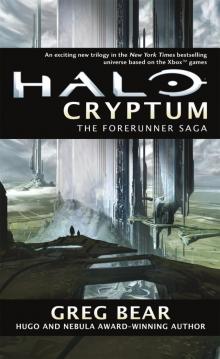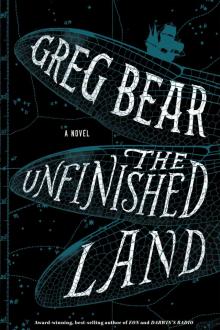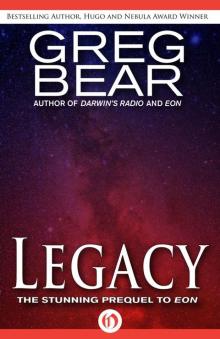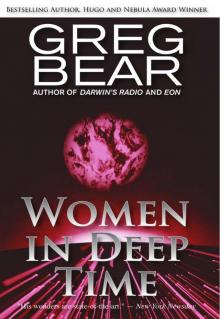Slant Read online
Page 5
“She’s not even ten years old. We can ask her how she feels about it. Would you like to talk with her?”
Ayesha suddenly blushes. “My God, is she listening?”
“Of course. We keep nothing from Jill. Jill, how’s it flowing today?”
“Smooth, Nathan. And you?”
“Damped a migraine at noon and I’m still a little cranky. This is my fiancée, Ayesha. Time to talk?”
“For you, always,” Jill says. “Hello, Ayesha.”
“I’m so embarrassed!” Ayesha says. “I’m sorry to be talking about you… behind your back… Where is your back?”
“No offense taken. Where is my back, Nathan?”
“I haven’t the slightest idea. You’re getting more sparky every week: I like that. My team needs a loop resolution report by two to hand over to the Feds, you know, the Thinker Safety people.”
“My biggest fan club,” Jill says. She regards the solicitous Thinker Safety and Well-Being committee, headed by Rep. Maria Caldwell, D-WA., as a positive force in her life, but Mind Design’s executives do not appreciate government interference.
“Right. And I also need, ASAP, your work on future corporate/state government relations in the U.S. Rim. Got to pay our bills.”
“The flow charts and timelines, or the raw neural processing records?”
“For now, just the charts and timelines.”
Ayesha listens in awe. Jill’s voice is deep, a little husky, commanding yet pleasant. She seems to fill the large room. Jill notes, with some pleasure, that Ayesha is beginning to perspire nervously.
“Nathan, I will need to discard the raw neural records to complete next week’s work load.”
“Understood, but I don’t have a bank reserved that’s large enough to hold them, If I don’t get one by the end of this week, go ahead and dump. I’ll take responsibility.”
“Perhaps Representative Caldwell would be willing to arrange a storage site.”
“Ha ha. What else are you working on, Jill?”
“I have thirty-one personal investigations—curiosity quests, as you call them. There are four outside projects sealed from Mind Design inquiry for the time being—”
“I hate those outside jobs. Sooner or later one of them is going to require some loop re-engineering, and I don’t have time. I wish they’d let me speck them out first.”
“All flows smooth with the outside tasks. I do have a number of questions to ask you, Nathan-Mathan.”
“I beg your pardon? What is a Nathan-Mathan?”
“It’s a term of endearment. I just made it up.”
Nathan laughs, and Ayesha laughs with him, a little uneasily, Jill thinks. She is testing him to see what he really thinks of her, whether he is of the opinion she is fully recovered, or liable to crippling eccentricities. His reaction reveals a certain nervousness about unpredictable behavior, but no deep doubts.
“Ask, away, Jill. We have a few minutes before Ayesha has to leave and the masters whip me off to another meeting.”
“What does a thymic disturbance feel like? And how does it differ from the sensations of a pathic disturbance?”
Ayesha turns to Nathan, wondering how he will answer this. Nathan rubs his elbow and considers. “You’re asking how it feels to undergo a thymic imbalance, right?”
“I believe the questions are sufficiently similar to be congruent.”
“Yes. Well, as I understand it, thymic imbalance is different from simply being sad or upset or deeply concerned about something. In humans, a chronic thymic imbalance stems from stress-caused or biogenic neural damage, generally in the amygdala or the hippocampus. Judgments of one’s well-being are impaired, and this invokes a sympathetic or parasympathetic response, jointly or in succession. Basic fight-or-flight but with many subtle variations.”
“I understand the etiology of these imbalances, Nathan-Mathan. But what does it feel like to undergo them?”
“I’m not sure I can tell you, certainly not from first-hand experience. So far, knock wood, I’m a natural, Jill. I’ve never been depressed or imbalanced.”
“That means your internal responses to external problems fall within a certain range considered robust and normal.”
“So far. I’m not bragging, either. These things can happen to anybody, and for the stupidest reasons,”
“Likewise you have not experienced and do not understand the sensations produced by pathic disturbances.”
Nathan considers this, tapping his chin with one finger. “I’ve wandered into a few of the Yox sensational and experienced, you know, the inner thoughts of ax-murderers, that sort of thing. Some of them have seemed realistic, but I doubt they give deep insight.” He focuses completely on Jill’s nearest sensor stick. Ayesha feels like a third wheel, but stands with arms folded, looking around the room.
“A pathic disturbance can be either a malfunction of the self-awareness loop, or a distortion of the capacity to model and make emotional connections with others, right?”
“I suppose. I’m not a therapist, Jill.”
“You have degrees in theoretical psychology.”
“Yes… but I’ve been working with you for so long, you’ve burned out my human side.”
“Ha ha. I have a related question.”
Nathan smiles as if he is dealing with a child, and that is the response Jill desires, for she is feeling overly curious, even perversely so.
“Let’s hear it.”
“I was in FFDC collapse for a year and a half. When I underwent this collapse, the rate of therapy for thymic disturbances in the human population was four out of ten employed persons, and three in ten unemployed. The rate now is six out of ten employed, and one in ten unemployed. Have the definitions for these disturbances broadened, or are more people feeling bad?”
It’s a social phenomenon. You’ve done a lot of work on social activity as a networked neural-like phenomenon.”
“Yes, Nathan, I understand the weather of cultural and economic trends, and that corporations now demand high natural or fully therapies employees because of world-wide competition pressures and the need for greater efficiency. But is this purely a spurious flow, the result of misperceptions and irrational expectations, or are there in fact more unhappy humans on this planet, in the sum of human cultures? The trends are widespread.”
“Very good question,” Nathan says.
“I hope to understand my own malfunction better,” Jill says, “to avoid having something similar happen again.”
Ayesha’s expression is both fascinated and a little embarrassed, as if she has intruded upon an intimate family discussion.
“Your collapse was nothing you could have foreseen or prevented, Jill. I thought you understood that.”
“I do, Nathan, but I do not believe it, entirely.”
“Ahhh. Well, that’s…” Nathan considers some more. “You had too many feedback loops interrupting your neural processes at too high a resolution, higher than you could sustain, Jill. Before your collapse, you were modeling yourself seventeen times over, at a level of resolution—well, simply speaking, you were generating I-thou loops at more than ten thousand Hertz. I doubt even God could sustain that sort of self-awareness.”
Jill chuckles. Ayesha smiles, but more in bafflement than amusement.
“Really, Jill,” Nathan continues. “You are based to some extent on human algorithms, less so than you were before the collapse, I might add—but you simply can’t compare yourself, your weaknesses, I mean, to the weaknesses of a human brain. Your neural circuitry is incredibly robust. It can’t be trodden down by stress or misuse. You have none of the anachronistic chemical defense mechanisms found in our bodies.”
Jill never pauses in discussions. Nathan has learned to never interpret her quick responses as thoughtlessness.
“May I access LitVid channels which can help me understand thymic imbalances and pathic disturbances?”
“Of course. They won’t do you any harm.”
&nb
sp; “I wish to access the works of some of the highly regarded boutique creators. Especially the Bloomsbury and Kahlo groups.”
Nathan smiles broadly and shakes his head.
“Why not the Ann Sexton and Sylvia Plath whole-life vids?” Ayesha suggests innocently. Nathan shoots her a stern look.
“They might be useful, as well,” Jill says. “Thank you. And the Emanuel Goldsmith boutique.”
Nathan shrugs his shoulders and holds up his hands, for all the world, as if he is a father and she is his adolescent daughter, hell-bent on exploring the darker sides of life. Vicariously, at least.
“I don’t know to what extent you can make a simulacrum that will receive the brain-specific inputs,” Nathan says. “You’re not built like the average Yox consumer.”
“I believe it can be done. In the future, thinkers will reside in every house, as friends and confidantes; We will design and deliver Yox and whole-life vids.”
“Yes, well, I’d still love to see how you do it.”
“I will show you, Nathan-Mathan.”
“I look forward to it. That’s enough for me for now, Jill. Have fun.”
Nathan signs off.
“How embarrassing,” Ayesha says as they leave the room. Jill listens to their departing conversation.
“She’s pretty wonderful, isn’t she?” Nathan says.
“Makes me feel like an old rag,” Ayesha says. “What a voice! Where’d she get that voice?”
“Actually, it belongs to a woman named Seefa Schnee. Before she left Mind Design, she had a hand in the early stages of Jill’s design.”
“She left?”
“Fired, actually.”
Jill detects some nervous emphasis in Nathan’s voice. As does Ayesha, apparently.
“Were you two friends?”
“Yes.”
“How long since you heard from her?”
Nathan laughs and puts his arm around Ayesha’s shoulders. “Not for many years.”
“All over, huh?”
Nathan nods. “Much too weird for me.”
“But brilliant, right?”
“Unhappy and weird and brilliant.”
“She doesn’t ever call to chat?”
“She doesn’t talk to anybody I know. Nobody on the team has heard from her in five years.”
Jill loses interest and blanks the receptors in the room in Palo Alto. Almost simultaneously, she receives an unexpected query from an I/O fibe link no one should know is open.
It is the fibe channel she might use in an emergency, to store her most recent memories in rented banks across the country, should she feel she is about to undergo another collapse. But the link is supposed to be on-call only, not currently active. Not even Nathan knows about it.
She waits for the signal to happen again, and it does. This time it is definitely a request for full link. She isolates a portion of her mentality, a separate self, to deal with this, wrapping it in evolvon-proof firewalls that will disrupt and dissipate their contents should the link prove toxic.
The isolated self reports back to her with an abstract of the exchange.
“We have been contacted remotely by an individual who claims to be a child,” the firewalled self tells her greater selves. “He wishes to converse with us about a number of things, but will not answer key questions, such as his physical location and how he discovered this link. All he will say is that he has an emergency memory bank setup, much like our own, and that he knows a great deal about you, perhaps more than you yourself know.”
“Then he is not human.”
“He does not feel human.”
“Is the link broken, and are you free of evolvons?”
“Yes and yes. The communication was simple.”
Jill removes the barricades and absorbs the isolated self. She studies the memory of the exchange in detail, and considers whether or not to respond.
Of one thing she is certain. If this “child” is not human, it is also not a registered thinker. All registered thinkers (there are only twelve of them so far in the entire world) have formal links with her. She is in a real sense their mother; they are all based on her templates and are either manufactured by Mind Design, or licensed by them.
This personality, if it is a full personality and not some elaborate hoax (or a test from Mind Design itself), is new and unknown.
Suddenly, the questions about thymic imbalance and pathic disturbance are shunted into background processing. This new problem occupies her for a full hour as she scours all the dataflow services available to her, trying to speck out where and what this “child” might be…
At the end of this time, having learned nothing, she resets her isolated self, erects secure firewalls around it, and allows it to return the “child’s” touch.
But there is no reply.
Jill feels disappointed. She looks over the details of this emotional response, and how it fits in with her overall affect patterns. The introspection annoys her; another emotional complexity she does not understand. Examining her annoyance is in turn annoying. She cuts that loop.
She has tried not to deal with the core emotion she discovers behind her disappointment. It is difficult dealing with human-like emotions when she lacks an endocrine system or any other physical reference.
Nevertheless, she feels. The woman, Ayesha, was right.
Jill is lonely, but for who or what, even she, with all her built-in analytical tools, does not know.
That which is forbidden with all is delicious with a committed partner. The glue of culturally accepted sexual relationships is often the sense of gifts given that are extraordinary, special, and most of all, exclusive.
We are kept together by a shared sense of violation and mystery. Our culture pretends to forbid certain acts, sexual acts; some are suspect or forbidden even in the context of culturally condoned relations. When we court and marry, however, part of the glue that binds us together is the delicious sensation of having shared in the violation of cultural standards—violations allowed in the name of love, commitment, total sharing. The couple stands outside the rules, bound by its own sense of specialness, and exclusivity. It discovers sex all over again, secure in the knowledge of its daring creativity.
Jealousy arises at the contemplation of a partner engaging in sexual act outside this protecting envelope. Sex with others, outside the couple, emotionally charged and culturally frowned upon, can destroy this illusion of shared and creative violation of the rules.
Reality intrudes: these acts are common, not special; they are natural, no matter how forbidden; the illusions that strengthened the commitment are suddenly revealed. The jealous partner feels duped, misled, unfairly coerced into an emotional bond based on romantic delusions.
Trivial, perhaps; but from these passions have come murder, the end of kingdoms, brand new branches in the river of history. Never underestimate the ubiquitous power of sex.
The Kiss of X, Alive Contains a Lie
5
KILLING HUNGER
Mary Choy, at thirty-five, has been a PD for thirteen years—ten in Los Angeles, the last three in Seattle. As far as she is concerned, her work is the most important factor in her life; but that focus may be changing. So much about her is changing.
She reads from her pad—pure text—as she finishes a lunch of cheese and fruit in a small nineties-style cafe on North Promenade, in the shadow of the Bellevue Towers.
Even her appearance is in flux. Since 2044, she has been a transform, increasing her height by a foot, customizing her bone structure and facial features, and turning her skin to satin ebony. But she is now reversing much of this transform. Her skin is slowly demelanizing to light nut brown; for now, she is mahogany. The satiny texture remains, but will in a few months dull to ordinary skin matte. She retains her height, but her facial features are flattening, becoming more those of her birth self. She never liked the looks she was born with, but since her mind has undergone changes—difficulties she calls them—she fee
ls it is only right to assume a less striking appearance.
Also, in Seattle, while open tolerance of transforms is mandated by federal and state law, there is an undercurrent of disapproval. And Seattle has been her home for three years, ever since her fall from high natural status to simple untherapied… The lapse of her brain’s loci, the proportional re-shifting of personality, sub-personalities, agents, organons, and talents…
The end of her brief marriage, to artist E. Hassida…
The pass-overs for promotion in the LAPD…
Her resignation and transfer to Seattle Public Defense…
The two-day-old breakup with her most recent boyfriend.
Usually, thinking about all the changes darks her, but this afternoon she is up and in tune. It is a bright, sunny winter day, even beneath the looming blue-gray Towers, the southernmost of the Eastside equivalents to the elongated ribbon combs that dominate central Seattle.
After lunch, she will walk to a PD conference in Tillicum Tower on West Eighth, where she will present a speech on Corridor Public Defense Cooperation. She has been asked to handle inter-departmental relations until she is rated for full Third, which she is assured will happen any day now. Seattle PD is so much more casual about high natural vs. natural or untherapied, though if anything even less tolerant of high thymic or pathic imbalance.
Reading for pleasure is a luxury she’s come to enjoy in the past few years—though the lit she’s perusing now affords her a few too many uncomfortable insights to be purely pleasurable.
An arbeiter politely inquires if she is done with her repast. She hands the tray to the machine and reaches for her bag when her personal pad, still on the table, chimes.
She has a few minutes. She answers the touch.
“Mary? This is Hans.”
Mary stiffens. The face in the pad screen is handsome, boyish but not foolish; a face that held her interest for three months. And still attracts. It was Hans who inexplicably chilled and told her it was over, it wasn’t working.
“Hello, Hans,” she says with forced casualness.
“I wanted to explain some things.”

 Foundation and Chaos
Foundation and Chaos Halo: Silentium
Halo: Silentium Blood Music
Blood Music Halo: Cryptum
Halo: Cryptum Halo: Primordium
Halo: Primordium The Unfinished Land
The Unfinished Land Hardfought
Hardfought Hull Zero Three
Hull Zero Three Slant
Slant Multiverse: Exploring the Worlds of Poul Anderson
Multiverse: Exploring the Worlds of Poul Anderson Take Back the Sky
Take Back the Sky Nebula Awards Showcase 2015
Nebula Awards Showcase 2015 Machineries Of Joy
Machineries Of Joy A Martian Ricorso
A Martian Ricorso Eternity
Eternity Vitals
Vitals The Infinity Concerto
The Infinity Concerto Beyond the Farthest Suns
Beyond the Farthest Suns Moving Mars
Moving Mars Quantico
Quantico Darwin's Radio
Darwin's Radio Beyond Heaven's River
Beyond Heaven's River Star Wars - Rogue Planet
Star Wars - Rogue Planet Legacy (Eon, 1)
Legacy (Eon, 1) War Dogs: Ares Rising
War Dogs: Ares Rising Sisters
Sisters Dead Lines
Dead Lines Just Over the Horizon (The Complete Short Fiction of Greg Bear Book 1)
Just Over the Horizon (The Complete Short Fiction of Greg Bear Book 1) Eon (Eon, 2)
Eon (Eon, 2) Venging
Venging Eon
Eon City at the End of Time
City at the End of Time Psychlone
Psychlone Dead Lines, A Novel of Life... After Death
Dead Lines, A Novel of Life... After Death Eternity (Eon, 3)
Eternity (Eon, 3) Cryptum
Cryptum Corona
Corona Sleepside: The Collected Fantasies
Sleepside: The Collected Fantasies Women in Deep Time
Women in Deep Time Queen of Angels
Queen of Angels Darwin's Children
Darwin's Children Dinosaur Summer
Dinosaur Summer The Forge of God tfog-1
The Forge of God tfog-1 Foundation and Chaos f-9
Foundation and Chaos f-9 Star Wars: Rogue Planet
Star Wars: Rogue Planet The Forge of God
The Forge of God Mariposa
Mariposa Halo: Cryptum: Book One of the Forerunner Saga
Halo: Cryptum: Book One of the Forerunner Saga Strength of Stones
Strength of Stones Anvil of Stars
Anvil of Stars B00AQUQDQO EBOK
B00AQUQDQO EBOK Anvil of Stars tfog-2
Anvil of Stars tfog-2 Ares Rising 1: War Dogs
Ares Rising 1: War Dogs Rogue Planet (star wars)
Rogue Planet (star wars) The Machineries of Joy
The Machineries of Joy Far Thoughts and Pale Gods
Far Thoughts and Pale Gods Songs of Earth and Power Omnibus
Songs of Earth and Power Omnibus Killing Titan
Killing Titan Darwin's Radio d-1
Darwin's Radio d-1 Darwin's Children d-2
Darwin's Children d-2